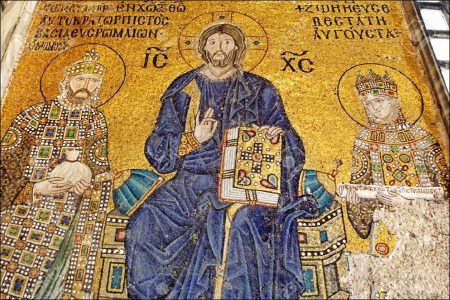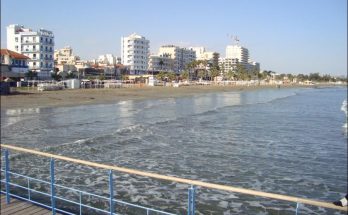The Narthex
The Narthex of St. Sophia is divided into vine bays with quadripartite vaults. Each bay gives access to the interior of the Museum, which thus may be entered through the great central portal and through the four lesser openings to the North and four to the South of it.
Above the marble facing of the walls extends a frieze of opus sectile (height, 0·47 m.) which is separated from the mosaic lunettes and vaults by a vine moulding of stucco. The length of a unit of the mould is 0·87 m. The frieze had by the nineteenth century fallen into a state of such dilapidation that the Fossati covered it with a copy of its design in paint, but it is possible to regain certain lengths of it intact.
The Mosaics
THE mosaics throughout the Narthex largely owe their preservation to the skilful work of Gaspare and Giuseppe Fossati, who between the years 1847 and 1849 were engaged at the command of the Sultan Abdulmecid in the task of renovating the Mosque and preserving the mosaics. Under their supervision the mosaics of the Narthex which cover the panels of the vaulted ceiling, the soffits of the arches, the lunettes over the doors leading into the Museum, the crenellated borders which trace the ribs, and the acanthus scrolls which frame the windows, were all re-established. Where disintegration was evident, plaster was introduced to fill the holes left by fallen tessellae and spread to grip those still in place, and sometimes even metal wing cramps and nails, regrettably of iron, were employed hastily, in order to effect local strengthening.
The golden ground of the mosaics of the ceiling and the geometric patterns and floriated designs which cover it and its component members were by this method consolidated and conserved without restoration. Missing parts of designs were frankly copied in paint and lee to view, but no restorations, in the sense of stripping off old mosaics and resetting them, or of introducing new ones, were attempted.
When these architects came to treat the mosaics in the lunettes and soffits A to I, in addition to the work of examination and reinforcement, they submitted the Byzantine representation in the central Lunette E, over the Royal Entrance, as well as the mosaic crosses in the eight other lunettes and in the soffits, to a covering of paint or of gold leaf, and by this means they partly concealed the work of the Byzantine artists.
The painters employed to draw the veil merely chose for the theme of their cumin Byzantine patterns from the mosaics of the vaulting of the Narthex close above their heads and copied them. The execution of this operation was of a very perfunctory character in stencil. No original design was introduced by them into the Narthex; and when during 1932 the surfaces were freed from the extraneous oil-painting, no Turkish work, and no ancient work, and no work of any merit whatever was destroyed. Sketches made by Major Cornelius Loos as late as 1710 show that the crosses were freely exposed at that time. It would thus seem that no screening of the Byzantine decoration in the Narthex had occurred up to the eighteenth century; nor are there traces of any earlier covering than that of the Fossati.
The mosaic work as fortified by the Fossati, both that in the areas beneath their painting and the large open tracts of gold background, was found generally to be well preserved. Investigation proved that the original composition of lime and powdered marble which was used to embed the Justinian mosaics varied throughout the Narthex. New batches of the mixture had been constantly made, and sometimes, perhaps, in careless haste. The blend used in Lunette D may have been faulty in its proportions; it yielded, at least, a weaker bed, which consequently showed some degeneration.
The gold ground was not covered as were the crosses. The paint covering the crosses varied in depth and strength. It was more solid and hence more difficult to remove in some lunettes than in the others. Nowhere, as in the Great Mosque at Damascus, was there a covering of plaster which could be cut off in strips. Neverthdess, in the work of removing from the mosaics the disfigurement of the paint it has not been found necessary to use solvents of any kind; the cleaning of the original mosaics has been accomplished by simple and innocuous mechanical means. The thin paint covering me mosaics is particularly amenable to flaking and was carefully removed tessella by tessella by means of a small steel chisel, such as has been used in delicately cleaning fossils and in scraping oil varnish and over painting from pictures. The liberation has been confined to the erasure of the paint; it was considered wiser not to disturb the plaster introduced by the Fossati into the interstices between the cubes, for it strengthens the decorations without defacing them seriously.
Still, surprisingly little of the original mosaic in the Narthex has been lost in the course of centuries.
The Frieze of Opus Sectile
The frieze of opus sectile constitutes a ribbon border formed of three longitudinal bands. These bands, of which the central one is wider than the upper and lower mutually similar ones, are edged by four plain, marble creases. The upper and lower creases are yellow and rosy in colour; the two creases framing middle band of the frieze are white.
The designs on the three bands of the frieze are of unequal force. The effect of the central band predominates over that of the upper and lower ancillary zones, each of which repeats a simple theme. This consists of a restrained, undulating figure produced by a series of loosely flowing M’s, presented alternately uptight and reversed.
Visits: 195



